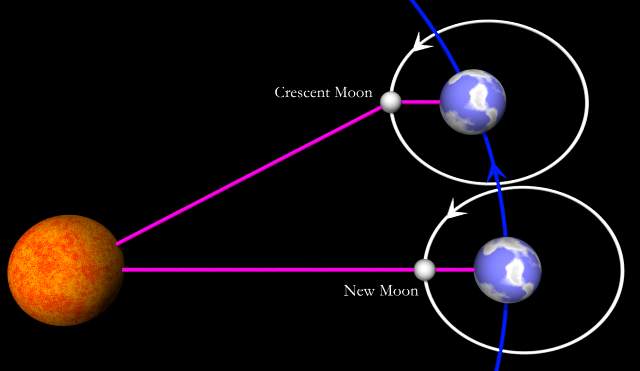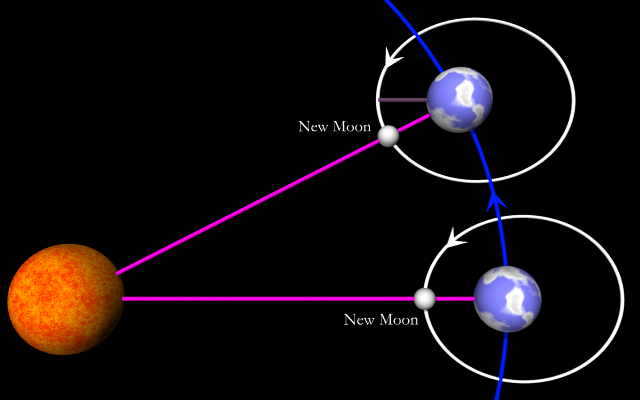Eclipses are, of course, caused by the orbit of the Moon around the
Earth. Since the Moon goes around the Earth once a month, this seems
fairly simple! But, as described in
Cycles of Eclipses, things are quite
a bit more complicated than that.
The problem is that the idea of a month isn't so simple: in fact,
in astronomy, there are no fewer than five kinds of month! Most of
these have some relevance to eclipse prediction, and so this page will
try to explain them in more detail.
Sidereal Month
The Moon's orbital period is the time it takes for the Moon
to complete one orbit around the Earth; ie. for it to go from "due
West" of the Earth, say, in the diagram below, once around the Earth,
and back to "due West" again. This period is known as a Sidereal
Month, and is 27.321661 days.
Seems pretty simple — but it isn't, quite! For example, you might
think that in a sidereal month, the Moon would go from a
New Moon to
the next New Moon. As you can see in the diagram, though, it doesn't
work; in the time it takes the Moon to orbit the Earth, the Earth
itself has moved, so that the Moon isn't between the Earth and the Sun
when the sidereal month is up — and, therefore, isn't a New Moon. So
while the sidereal month seems like the simplest view of what a
"month" should mean, astronomically, we'll see that the other kinds of
month are actually more interesting from an Earthly point of view.
Rotational Period: The rotational
period of the Moon is the time it takes for the Moon to complete
one rotation on its axis. Interestingly, since the
Moon's rotation is synchronised, by tidal forces, with its orbit
around the Earth, the rotational period is exactly the same as the
orbital period: 27.321661 (Earth) days. Because of this, the Moon always
keeps the same face turned towards us (give or take a few degrees of
variation, caused by the Moon's orbital inclination).
The far side is therefore never visible from Earth, and is
consequently known as the "dark side" — "dark" in the sense of
unknown, obscure, hidden, etc.; it wasn't until
the Soviet spacecraft Luna 3 photographed it in 1959 that we got our
first view of the Dark Side of the Moon. By now, of course, the whole
Moon has been thoroughly mapped and photographed by orbiting probes
and astronauts.
Bear in mind that the Moon does, in fact, rotate, and because of this
every spot on the Moon sees day and night in the same way as on
Earth — albeit that the
lunar days and nights are each 14.8
Earth days long. So there is no permanent "dark side of
the Moon" in terms of illumination.
Note that the rotational period is not the same as a
lunar day!
Anomalistic Month
The Moon's orbit around the Earth is not, in fact, circular; it's
elliptical. Only slightly, but enough to mean that the Moon isn't
always the same distance from the Earth.
Two points in the Moon's orbit are of special interest:
- Apogee is the point in the Moon's orbit that is farthest
from the Earth;
- Perigee is the point in the orbit of the Moon that is
closest to the Earth.
The points of apogee and perigee are not fixed relative to the
Earth. This is due to regression of the Moon's orbit; the "long"
dimension of the elliptical orbit, and hence the points of apogee and
perigee, circle around the Earth about once every 9 years. Thus, the
time it takes the Moon to travel from apogee to perigee and back again
is slightly longer than its orbital period (the
Sidereal Month). This period of
time is called an Anomalistic Month, and is 27.554549 days.
The Anomalistic Month is interesting for solar eclipses, because
the "size" of solar eclipse that we see —
and the type of eclipse, whether it is
partial, total, annular, or hybrid — depend on the distance from
the Earth to the Moon during the eclipse; and this distance depends on
the point during the Anomalistic Month when the eclipse occurs. For
lunar eclipses, the duration of the
eclipse, and the appearance of the eclipse, are also affected by this.
But for actually predicting the occurrence of an eclipse, we need
two more kinds of month!
Synodic Month
As we described in The Earth and Moon,
a very clear cycle is visible when you look at the Moon from the Earth:
the cycle from New Moon, through crescent, half and gibbous Moons, to
the Full Moon, and back again. It may seem that this cycle should be
the same as the Sidereal Month, but once
again, things aren't so simple!
The problem is that as the Moon is orbiting the Earth, the Earth is
going around the Sun; and while the Moon is busy completing its orbit
of the Earth, the Earth moves a twelfth of the way around the Sun. As
you can see in the diagram above, this means that starting from a New
Moon, the Moon has to go around a full orbit and a bit more to get
back in between the Earth and the Sun again.
The time it takes for the Moon to go from one New Moon to the next
is called a Synodic Month, and is 29.530589 days on average.
Because the orbits of the Earth and Moon aren't circular, and hence
the two bodies don't move at a constant speed, the
actual time between lunations may range from about 29.27 to about
29.83 days.
Lunar Day: The length of a day on the
Moon is the time it takes for the Sun, as seen from an observer
standing on the Moon, to go from overhead to overhead. Again, this is
not the rotational period of the Moon, because the Moon has moved
round the Sun during that period; so, a Lunar day is the same as the
time it takes for the Moon to go from full to full: ie. one Synodic
Month, or 29.530589 days.
One thing that may occur to you: if the Moon's day isn't the same
length as its rotational period, what about the Earth? The answer is
that the same thing applies on Earth: because the Earth is orbiting
around the Sun at the same time as it's rotating, a sidereal day on
Earth — which is one complete rotation of the Earth on its axis —
is 23 hours, 56 minutes, 4.06 seconds, which is less than a solar day
of 24 hours.
Draconic Month
The diagrams above show the Earth and Moon as seen from above; in this
view, things look pretty simple and two-dimensional. Unfortunately,
reality is just a little more complicated than this. To understand
the next type of lunar month, we'll need to take a slightly different view.
As described in
Cycles of Eclipses, the Moon's orbit
is tilted to the plane of the ecliptic; the two points at which the
orbit intersects the ecliptic are known as nodes. In order to
get directly between the Earth and the Sun, the Moon has to be in the
plane of the ecliptic; and therefore has to be at one of the two
nodes. So the time the Moon takes to travel from a node, around its
orbit, and back again, is of great interest.
Once again, this period is not quite the same as a single orbit,
due to precession of the Moon's orbit; the Moon's orbital plane, and
hence the nodes, rotate backwards around the Earth about once every
18.6 years. The time taken for the Moon to return to a node is
therefore shorter than its orbital period; this time is known as a
Draconic Month, and is 27.212220 days. This is sometimes
called the Nodal Month.
Incidentally, the term "Draconic" refers to a mythological dragon,
that supposedly lives in the nodes and regularly eats the Sun or Moon
at an eclipse.
The Saros
So where does all this leave us? Well, as we've seen, an eclipse
happens when the Moon is at one of the two nodes; and the period which
determines this is the Draconic Month.
However, the Moon also has to be aligned with the Earth and the Sun,
ie. at a New Moon (producing a solar eclipse) or Full Moon (for a
lunar eclipse); and the period governing this is the
Synodic Month. When these two
cycles coincide, an eclipse occurs!
Now, it happens that 223 Synodic months is 6585.321 days; and 242
Draconic months is 6585.357 days, which is almost the same, and indeed
close enough to produce an eclipse. This period, of 18 years, 10 and
a third days, is known as the Saros; this is the period at
which similar eclipses (ie. eclipses belonging to the same Saros
cycle) re-occur.
The slight difference between the two totals is why successive
eclipses in a Saros series do, in fact, differ; the eclipses in a
series migrate gradually from North to South or vice versa.
The odd third of a day (roughly) is the reason why successive Saros
eclipses occur over completely different parts of the Earth: the Earth
has rotated a whole number of days plus a third between the two
eclipses. On the other hand, this means that 54 years and 32 or 33
days (depending on leap years) after an eclipse, another eclipse in
the same Saros series will occur, and the Earth will have rotated back
roughly to where it started. This leads to another eclipse cycle
— the Triple Saros, which is three times the Saros period.
This is the interval over which similar eclipses will occur over the
same side of the Earth, but shifted significantly North or South.
Finally, there are many different combinations of circumstances
which can cause an eclipse: Moon at its rising node, Moon at the
falling node, etc.; and this is why there are 42 Saros cycles running
at any one time, and hence why we get several eclipses (solar and
lunar) per year.
Tropical Month
Just for completeness, one more month you might come across is the
Tropical Month, which is the period from one lunar equinox to
the next, and is 27.321582 days.




